Impatience plays a big role in my life, in terms of my eating habits. Like this weekend, when I made hummus.

Sometimes, when you wake up early in the morning on Saturday with loads of free time ahead of you, you feel like planning a big menu and spending the day in the kitchen. Other times, you’d just as soon eat cereal rather than putting in any actual effort. But that’s not always the healthiest option.
A quick and easy bean spread like this one is just the thing, full of savory flavor, and packed with nutrients and fiber that you need to get through the day.
I don’t remember the first time I had hummus, but I can almost guarantee I didn’t like it, not right away at least. I’m sensitive to certain textures and flavors, and to me, hummus is different than other appetizer-like spreads.
It’s not dairy-based and made with something like cream cheese or sour cream, and it’s not exactly a dip, but more of a spread, at least the way I like it. But it is still creamy, and it can be super satisfying.
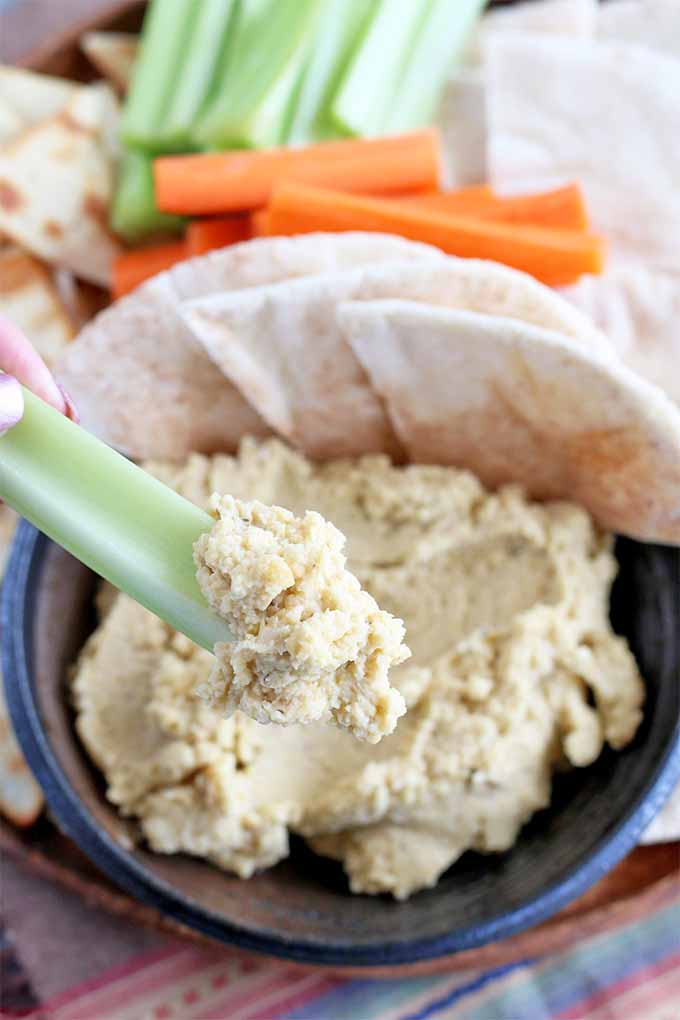
Made with chickpeas, hummus originates in the Middle East. It’s the kind of thing you’re sure to find at hookah bars and specialty grocers or, if I remember right, that tiny Arabic kebab place I stopped in one time where the owner gave me free falafel, because I told him I’d had it before, and he said his would be better.
Today, hummus has become so popular that you can find it just about anywhere, at farmers markets and lining the shelves of your local grocery store.
Over the past few weeks, after repeatedly seeing it and hearing about it in so many places, I finally caved. On Friday night, I rushed straight from the office to the store, in search of a can of chickpeas.
With near-instant gratification in mind (I had lots of things I wanted to do this weekend!) I whipped up a big batch, and I wasn’t disappointed. Whether you’re using fresh or dried herbs, adding a dollop of store-bought roasted garlic from a jar or making your own from scratch, you won’t be, either.
A Note on the Beans
Let me cover two things about canned chickpeas before we go any further:
1. Apparently, there are people who will say you are committing hummus sacrilege when you use canned chickpeas instead of dried. If you are one such person, I promise, I am not out to ruin the hummus experience for you.
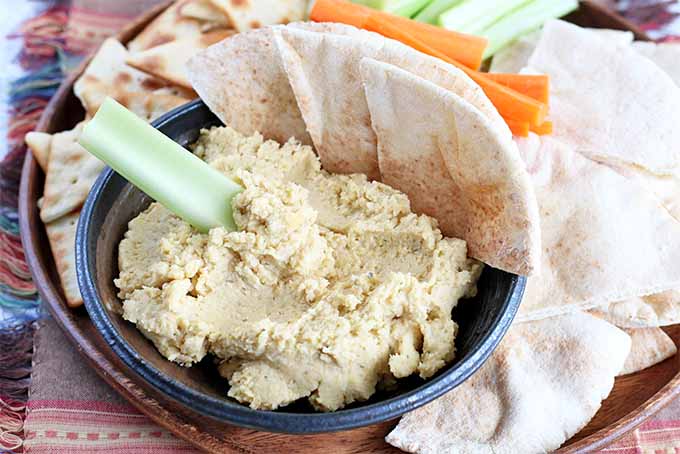
Others even painstakingly peel every skin from every single bean before dropping it into the food processor. I am not one of these people, and I don’t think my resulting creations suffer as a result. I’ll let you be the judge.
2. Chickpeas are garbanzo beans. Garbanzo beans are chickpeas.
Though different cultivars of Cicer arietinum do exist, with some being larger and others on the smaller side, these all come from the same species of plant. You may also hear them referred to as gram, or Egyptian peas. This was something I did not know until recently.
Texture and Flavor: Find Your Fit
Since my very first taste, way back when, one of the defining characteristics of this spread stands out to be above the rest: texture.
The kind that I prefer is creamy and thick; it’s stable enough to hold its shape when you dollop a bit onto your plate, like mortar that you would spread on bricks, smooth and sturdy and substantial.
I like it best slathered on hot, buttered pita, its cool paste-like consistency dissolving on my tongue.
Others might like it a bit thinner, made with a few extra glugs of olive oil, or chunky with whole chickpeas thrown in for garnish before serving.
Personally, I like cold hummus. But if you like yours hot, by all means, give it a quick pop in the microwave or heat it up on the stove at the end. A drizzle of melted butter on top provides an extra-decadent experience.
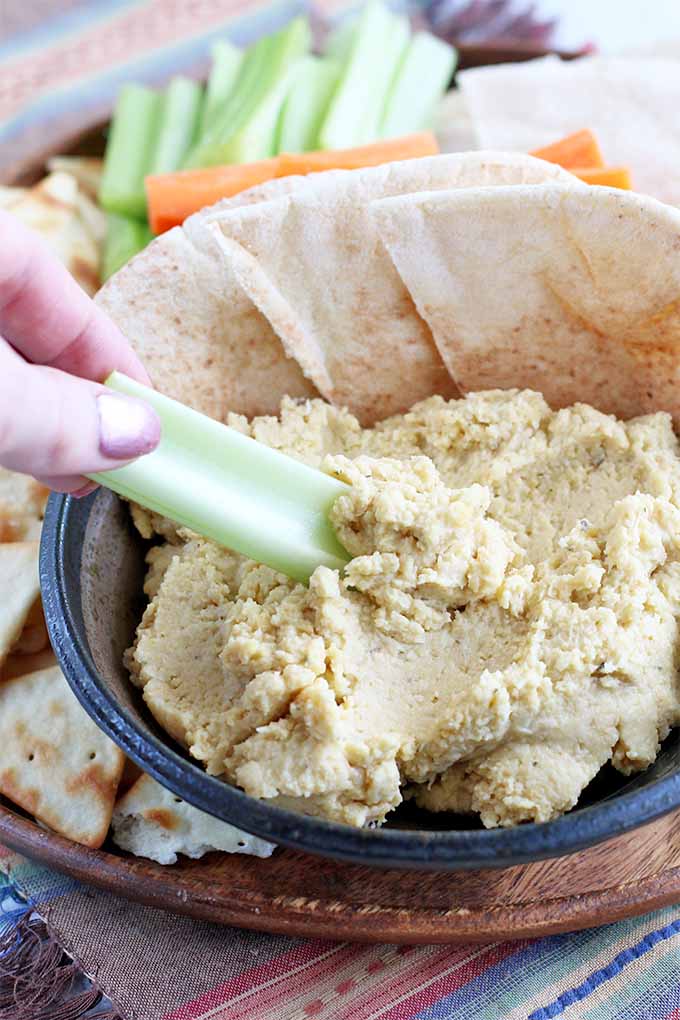
In terms of flavor, there are nearly endless taste variations out there. The garbanzos themselves are sort of a blank canvas, just begging for the addition of herbs and spices.
This particular recipe stands out because it doesn’t use tahini. I know purists may deem this unorthodox choice to be a deal breaker, but there are some eaters out there who don’t like the somewhat bitter taste of sesame seed paste, and others who are allergic. Maybe this is why I wasn’t a fan of the first version that I tried.
In my case, I didn’t want to buy a whole bottle of tahini for just one recipe (though I could use the rest of it to make banana smoothies!), so I used what I had and still managed to make something delicious. For this version, I’ve left it out, but you can feel free to add a tablespoon or two to taste if you like.
Also, this is garlic hummus, and I am a firm believer that most foods are improved with a little garlic thrown in. A few pinches of fresh oregano adds a lovely herbal Mediterranean flavor.
So, here’s what I recommend: start with the basics, then do a bit of exploring and make it your own. I hope you land on a favorite soon, and that you make this recipe regularly.
Print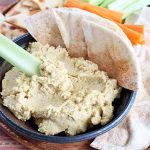
The Best Roasted Garlic Hummus
- Total Time: 45 minutes
- Yield: 6 servings 1x
Description
Roasted garlic adds depth to traditional chickpea hummus, plus fresh oregano, lemon, and a dash of cayenne to make this homemade dip extra special.
Ingredients
For the Roasted Garlic:
- 1 head garlic
- 1 tsp olive oil
For the Hummus:
- 1 15-oz. can chickpeas
- 2 tablespoons minced roasted garlic
- 1–2 tablespoons tahini (optional)
- 2 tablespoons olive oil
- ½ tablespoon lemon juice
- 1 teaspoon fresh oregano leaves (or 1/2 teaspoon dried)
- ½ teaspoon salt (or more, to taste)
- ¼ teaspoon cayenne pepper (optional)
Instructions
To Make the Roasted Garlic:
- Preheat oven to 400°F. Using a sharp knife, slice off the top of the head of the garlic. Drizzle with olive oil, rubbing the oil into the exposed clove tops. Wrap tightly with aluminum foil.
- Bake for 30-35 minutes, until cloves feel soft when pressed. Remove from the oven, open the foil packet, and allow to cool. Reserve 2-3 cloves for this recipe, and save the rest for other uses.
To Make the Hummus:
- In a food processor, process the chickpeas, garlic, tahini if you choose to include it, olive oil, lemon juice, oregano, salt, and cayenne (if using) until it reaches the desired consistency.
- If hummus is too thick, simply add olive oil in small increments 1/2 teaspoon at a time, and pulse to mix. Adjust seasoning to taste.
- Prep Time: 10 minutes
- Cook Time: 35 minutes
Cooking By the Numbers…
Step 1 – Measure Ingredients
Wash the produce, and measure all of the ingredients so you have them ready.
Drain the chickpeas in a colander placed over a large bowl. You can save the liquid (or “aquafaba”) to use as an egg replacement in baking, or to make homemade vegan mayonnaise.
Using a garlic press, mince the garlic. Juice the lemon, and separate the oregano leaves from their stems.
Step 2 – Puree
Add all of the measured ingredients to your food processor. If you like a bit of heat in your hummus, you can add 1/4 teaspoon cayenne pepper to enhance the flavor.

Instead of food processor, a high-speed blender or immersion blender could also be used.
Pulse, scrape down the sides with a rubber spatula, then process until the mixture is smooth.
Step 3 – Adjust Consistency
If the hummus is thicker than you like, add olive oil 1/2 teaspoon at a time.
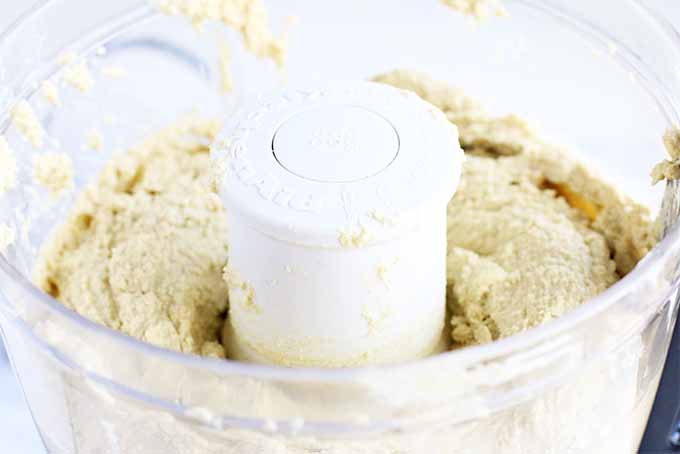
Pulse until combined and the texture is to your liking.
Step 4 – Season
Season with salt to taste.
Serve roasted garlic hummus with cut pita bread, pita chips, or crackers like buckwheat cheddar or parmesan rosemary. You can also use it as a spread on sandwiches, or serve a tablespoon on top of your favorite salad for some added protein.
Roasted Garlic = Savory Heaven
Roasted garlic is the key to the intense, savory flavor of this hummus. Slowly roasting the garlic gives a richness to the flavor that can’t compete with what raw minced garlic has to offer.
Adding the tang of lemon juice and herbaceous, floral oregano flavor notes really gives the creamy dip some extra life.
No one will be able to resist when a bowl is set in front of them. Plus, the heavenly smell of roasted garlic will fill your home, making your mouth water the moment it hits your nostrils.

Forget candles; when you have roasted garlic filling your home, no other aroma is necessary.
What do you love to add roasted garlic to? For even more deliciousness, try this classic homemade bread recipe.
Be sure to tell us what you think in the comments below. And don’t forget to give the recipe a rating!
Photos by Meghan Yager, © Ask the Experts, LLC. ALL RIGHTS RESERVED. See our TOS for more details. Originally published on February 2nd, 2009. Last updated: July 18, 2022 at 17:04 pm. With additional writing and editing by Allison Sidhu.
Nutritional information derived from a database of known generic and branded foods and ingredients and was not compiled by a registered dietitian or submitted for lab testing. It should be viewed as an approximation.
About Shanna Mallon
Shanna Mallon is a freelance writer who holds an MA in writing from DePaul University. Her work has been featured in a variety of media outlets, including The Kitchn, Better Homes & Gardens, Taste of Home, Houzz.com, Foodista, Entrepreneur, and Ragan PR. In 2014, she co-authored The Einkorn Cookbook with her husband, Tim. Today, you can find her digging into food topics and celebrating the everyday grace of eating on her blog, Go Eat Your Bread with Joy. Shanna lives in Nashville, Tennessee, with Tim and their two small kids.

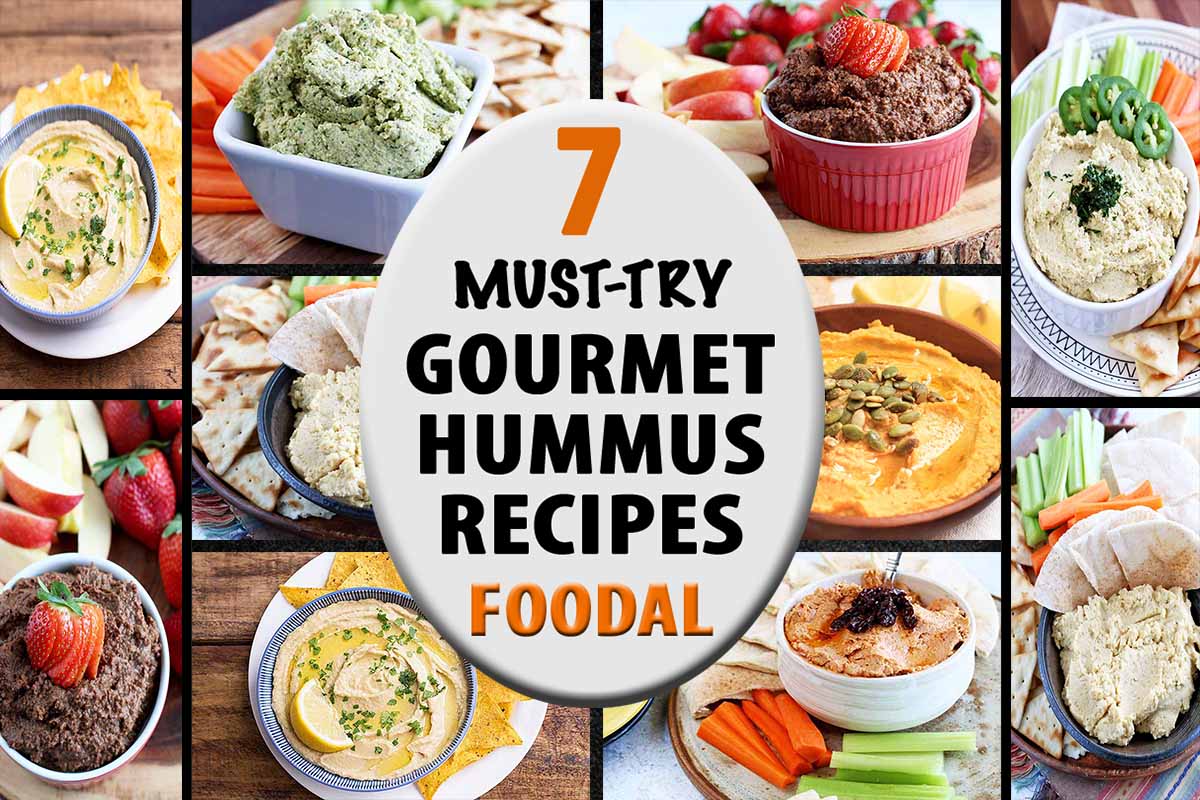


I totally use canned chickpeas in mine. And I had a similar experience to your falafal guy except with hummus. I went to a little Jerusalem market, and I asked the guy if his hummus was good. His response? A slightly offended “It is the best!” Oops. And, umm, I think mine is better. At least to me. It’s almost against all things good to say that, but oh well. I do use tahini, but the man likes hummus, so we eat it quite a bit. Anyway, great post. It made me laugh and reminded me that I haven’t made hummus in a few months. Time to get crackin’. And I’m sorry about the wait at the post office. I waited to half an hour to find they wouldn’t ship my package at all because it was in a wine box even though there was no wine. DANG. IT.
i loooove hummus, it started off rocky but now, i just love it. i’ve made it once and really, it’s just so much easier to buy it already made.
fyi, you can actually print out shipping labels from usps online. if your office has a mailman already dropping off and picking up mail, s/he’ll take packages too. ever since the holidays i’ve been printing out my own labels and i doubt i’ll ever walk into another post office during my lunch break again.
I’ve always liked hummus. I really like roast garlic, too.
i love hummus. i usually try to soak dried ones overnight, but you are right, i can barely tell the difference when i use canned ones!!!
It’s about the spice! Either cayenne, Tabasco or red chili powder in there. Really gives it ooomph! It’s probably more a spread than a dip? Hard to say. We like to dip stuff in it and slide it on sammies. 🙂
mmmmmmmmm. love hummus… had gooood hummus at the Holy Land Exp in Orlando– of all places!!
I love hummus! I’ve only had homemade hummus once but it was very good. Love the flavor.
I totally love hummus. (I never thought about buttering the pita — mmm!)
Having no tahini is fine by me — I had been reading so much about its health benefits that I bought a big, expensive jar of it. It did not taste very good — some flavor I can’t put my finger on was just not doin’ it for me. Plus, as you said, we don’t want to buy all that much just for the little that goes in the hummus.
I’ll definitely try your recipe; it looks easy and delicious! I love it that it uses basic, normal ingredients.
Kalamata olives, feta cheese, and tomatoes would be a lovely addition/garnish for this, by the way. A restaurant near me has the most awesome Mediterranean hummus using those toppings.
Thank you for your blog. I really enjoy it.
I recently had the pleasure of eating hummus at an office party, it was absolutely to die for and since I liked it so much I decided to make some for my family. The recipe calls for Tahini but the grocer I go to does not carry Tahini and so I used peanut butter as a substitute. It turn out to be quite good, so for those of you who are willing to experiment a bit, the next time you make hummus, try peanut butter as a substitute for Tahini. You will be amazed.
Another similar spread is baba ganoush, has similar consistency and testure as hummus. There are many variations to making this delightful spread and I am sure if you google it, you’ll find the one recipe for you. Enjoy eating!
Good post. You reminded me why this almost ubiquitous spread is so delicious. We generally used canned beans for humuss, dried beans for falafel…I like the creamy texture that’s so hard to get with dried beans.
TJ: I know! Roast garlic is AMAZING.
Montague: You’re nice. Thanks for saying that!
DD: I’m a little wary of spicy things, so I need to ease myself into more kicked-up versions. Small steps, right?
Rachel: I went there one weekend in college – so random, especially since I never got to Disney! I remember the food was the best part.
Jessica: I’d love to know what kind the homemade version you had was?
Jennifer: How great would it be to make this in the summer and have fresh, sliced tomatoes on the side? You’re right – that sounds so good. And thanks for your nice compliment. You’re very kind.
Kiet: Peanut butter? Really? How intriguing! I don’t know if I’ve ever tried baba ganoush before, but I’m interested. Thanks for the tip!
Molly: Another kind encourager. Thank you for making me feeling a little better about the canned beans!
Mmmm roast garlic…
Houmous, baba ganoush, and tsatziki are the holy trinity of dips in our house. They are mostly bought (in my defence it is from a Turkish shop) and chickpeas are mostly (or always) canned. I’m just not organised enough for dried.
Yes, peanut butter. Tahini is sesame paste, if you don’t already know and has about the same consistency as tahini and is something easily found in every household. The very reason I use peanut butter is so I don’t have to spend money buying a large jar of tahini for one or two dishes and the rest just sits for an indefinite amount of time, quite wasteful, really.
As for the baba ghanoush, it’s roasted eggplant and garlic processed into a spread. Most Baba Ghanoush recipes call for Tahini. I use peanut butter as a Tahini substitute and instead of using fresh garlic, I roast mine. It is quite lovely. Enjoy cooking!
Mmmm I just made this for lunch and it was amazing! I’ve never been a big fan of tahini, but was always afraid to leave it out. Good call!
Gemma – I love tsatziki. Like, love, love it.
Kiet – I’m mentally adding baby ghanoush to my list of things to try. Thanks for the tip!
Belle – Oh, I’m so glad!
You mentioned that you used the tahini that you had on hand but the tahini does not appear in the recipe. Did you or did you not use tahini? Also, enlighten us all with your process of mincing roasted garlic. Roasted garlic is soft and buttery so mincing it would be a little like mincing butter, wouldn’t you say?
Great questions, Walther. The tahini is an optional ingredient, but you could add 1-2 tablespoons if you choose to include it. And you’re correct that roasted garlic is very soft. The idea here is to chop it up a bit before adding it to the food processor, to facilitate smooth blending. We’ve found that even roasted garlic, when added whole, may result in uneven distribution in the final product. We’ve updated the article and the recipe card as well for clarity.